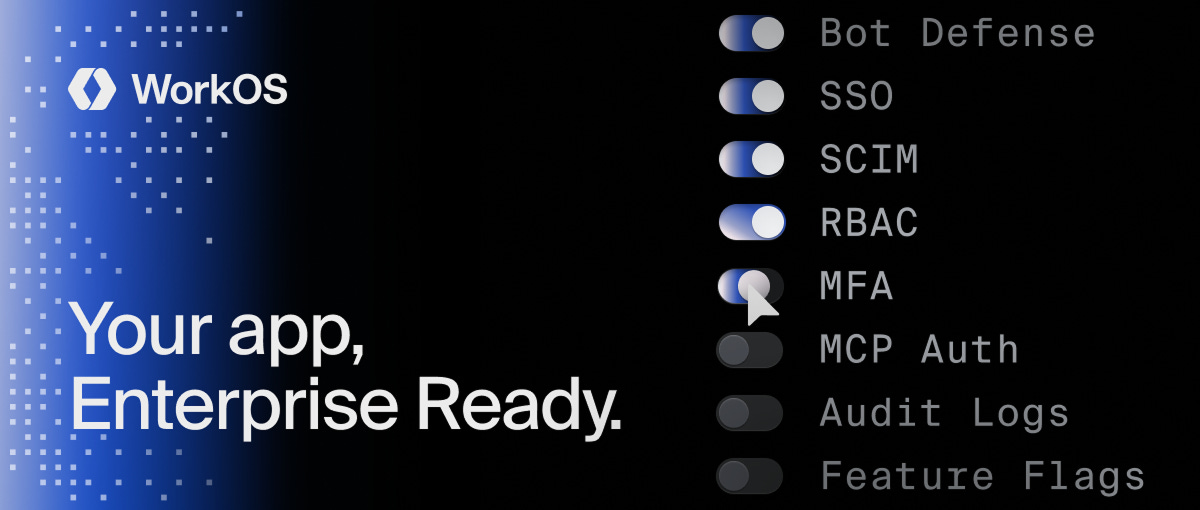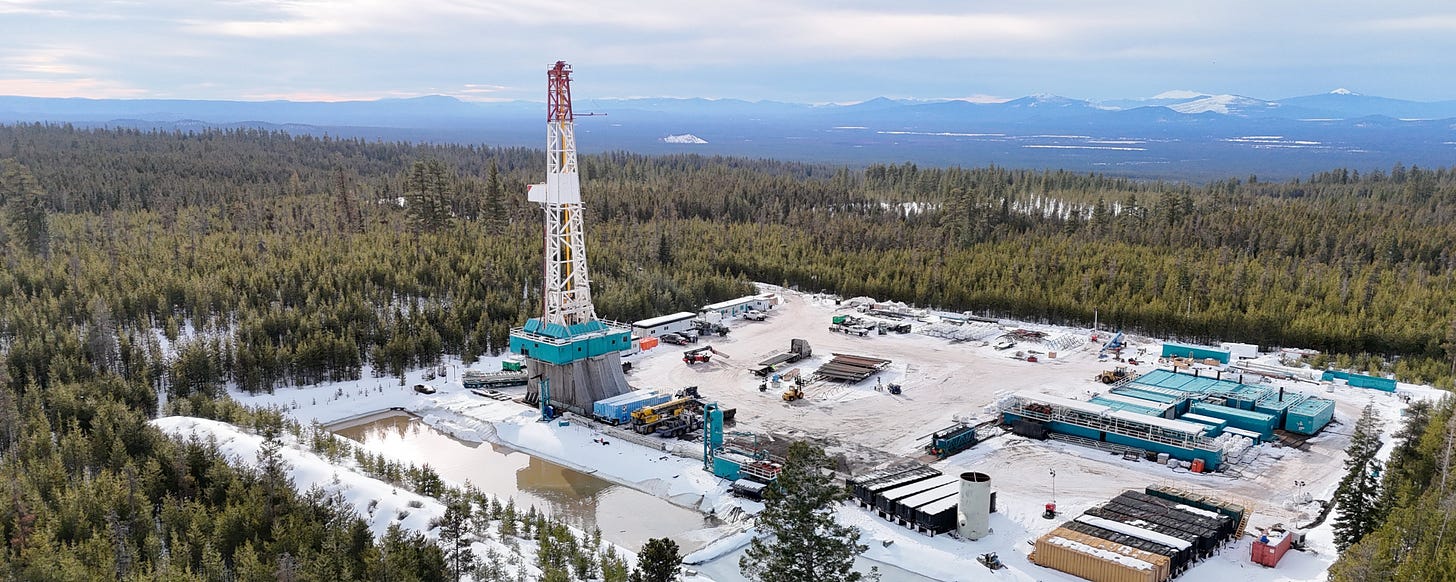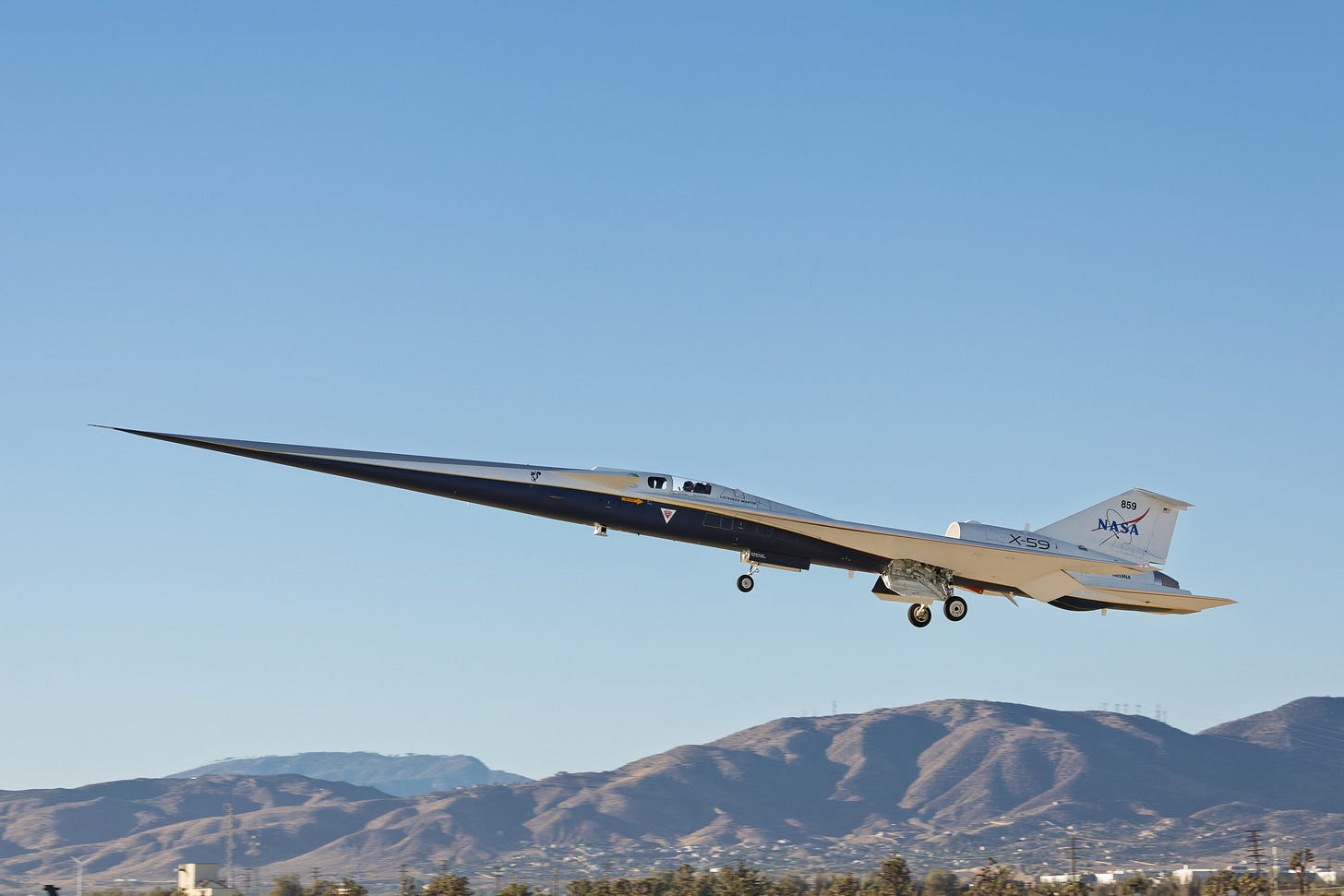Weekly Dose of Optimism #168
Substrate, Extropic, Super Hot Geothermal, Compact Nuclear, NEO House Robot + J. Storrs Hall and Skunk Works' X-59
Hi friends 👋,
Happy Friday and Happy Halloween! There’s going to be a lot of scary stuff happening on the streets tonight, but here in the Weekly Dose, it’s all treats.
We’ve got new American chip technology, new power generation, a little biodefense, a $20k robot you can actually buy right now, and a whole lot of bonus content.
Looks like the good guys decided to dress up as incredibly productive for Halloween.
Let’s get to it.
Today’s Weekly Dose is brought to you by… WorkOS
The Platform Powering Auth, Identity, and Security for AI Products
Enterprise customers expect more than a login screen. They demand SSO, directory sync, granular permissions, and detailed audit logs, all built to strict compliance standards.WorkOS gives growing teams these enterprise foundations without slowing development:
- Modular APIs for authentication and access control
- A hosted Admin Portal that simplifies customer setup
- Built-in security and compliance features enterprises require
Trusted by OpenAI, Cursor, and Vercel, WorkOS powers auth, identity, and security for AI products across the industry. Your first million MAUs are free.
Start building with WorkOS today →
(1) Substrate Unstealths Next-Generation Foundry to Compete with ASML & TSMC
From Semianalysis
Substrate is a recently out-of-stealth Bay Area startup inventing “technology to power next-generation foundries” with the mission to substantially reduce the cost of advanced logic wafers. The first major step towards this mission is a new X-ray lithography (XRL) tool that the company has invented.
Substrate, a startup using x-ray lithography to build a new semiconductor foundry in America, came out of stealth on Wednesday with $100 million from Founders Fund, General Catalyst, Long Journey Ventures, Valor Equity Partners, In-Q-Tel, and Allen & Co, and a launch fit for a Lulu & Gaby client. There was a Semianalysis analysis, a Ben Thompson interview, a TBPN appearance, a Cyan tattoo, and of course, a sick video.
This is one of the more ambitious startups to come out in a while. Its plan is to take on two of the giants in the chip supply chain, ASML and TSMC, which have a combined market cap north of $1.7 trillion. ASML’s EUV lithography machine is perhaps the most impressive in the world; there’s some stat like its mirrors are so smooth that if they were blown up to the size of Mars, the biggest imperfection would be a credit card’s height tall.
Unlike ASML’s extreme ultraviolet (EUV) systems, which rely on complex plasma-based light sources operating at 13.5 nm wavelengths and costing over $400 million per machine, Substrate’s technology harnesses compact particle accelerators to generate X-ray beams with significantly shorter wavelengths that are billions of times brighter than the sun. That would mean superior resolution for etching microscopic patterns on silicon wafers, achieving critical dimensions as small as 12 nm and via pitches of 30 nm, matching or exceeding the capabilities of 2 nm process nodes while offering greater depth of focus and reduced need for multi-patterning. The result is a more precise, efficient process with lower operational complexity, fewer consumables, and drastically reduced costs.
They hope to slash leading-edge wafer prices from $100,000 to around $10,000 by the end of the decade. As importantly, it would mean that America would control two key steps in the supply chain for which it currently relies on Dutch and Taiwanese partners. Substrate could make America a vertically integrated chipmaking nation, and is deeply vertically integrated itself: in addition to lithography hardware, it’s making specialized chemistry, resists, and full front-end manufacturing lines to build a network of American fabs.
God Bless America, and God Bless Vertical Integrators.
(2) Extropic Unveils XTR-0 Thermo Chip and Open Source THRML Library
From Extropic
While we vertically integrate our ability to produce GPUs, Not Boring Capital portfolio company Extropic rolled out a prototype of its new Thermodynamic Sampling Units, or TSUs.
As I wrote yesterday in Take Weird Ideas Seriously, Extropic’s goal is to make AI much more energy efficient by taking advantage of the natural wiggle of electrons to generate free probability distributions. While this won’t achieve the 10,000x energy efficiency improvement on current AI workloads, not all of which are probabilistic, the company also released an open source THRML library for developers to start playing with, and hopes that new types of non-transformer models will be build on top of its hardware.
It’s great to see Beff, Trevor, and the team turn their weird idea into a real, working product. While victory isn’t guaranteed, this increases the … probability … that they make a dent in how humans produce digital intelligence.
(3) Mazama Energy Unveils the World’s Hottest Enhanced Geothermal System
From Vinod Khosla
Mazama Energy…today announced a technologically significant leap for clean energy: the creation of the world’s hottest Enhanced Geothermal System (EGS) at its pilot site in Newberry, Oregon – at an unprecedented bottomhole temperature of 629 °F (331 °C). They expect to reach 750 °F (400 °C) in 2026 which could produce many GWs of clean electricity from this one location. Harnessing these superhot resources will allow Mazama to extract up to 10x more power density, use 75% less water, and drill 80% fewer wells than current approaches.
Geothermal, so hot right now, geothermal.
Whether Extropic succeeds in making inference more energy efficient, we’re going to need lots and lots of energy to power our electric future. Solar and nuclear are on the way to producing a lot of cheap, clean energy, and geothermal has shown a lot of promise, but the challenge has been it’s just not cheap enough. As Eli Dourado told us on Age of Miracles, super hot geothermal is roughly 400° C at the surface.
Super hot is important because energy extraction potential from geothermal wells increases exponentially with temperature. Mazama’s superhot temperatures enable 10x more power density per well compared to conventional geothermal. This is because the enthalpy (energy content) of steam increases dramatically at higher temperatures, and you can generate far more electricity from the same flow rate of fluid.
Practically, this means cheaper, more cost competitive geothermal. Drilling is the major capital expense in geothermal; if you can get 10x the power from each well, your cost per megawatt plummets. Mazama is targeting under 5 cents/kWh, which makes it competitive with natural gas without subsidies.
Geothermal has the potential to bring clean, baseload power on fast. We here at Not Boring want all of the clean, safe, reliable power we can get. Let’s get steamy.
The thing about geothermal, though, is that you can’t take it with you. The well is where the well is. But what if you could make an “ultra compact power box that can generate energy for years without refueling”?
That’s what Mersenne, announced earlier this week, is attempting to do.
As co-founder Kevin Sekniqi writes, “Humans have never before built power that can last for years or decades and that can be used anywhere it is needed. Current choices are either long-duration and stationary (grid) or short-duration and mobile (fossil fuels / chemical batteries). This is a false, self-inflicted dichotomy.”
Mersenne is building STARFALL V1, a terrestrial power system that produces 40 kWe energy continuously for years. That’s enough to power a house. Ultimately, it wants to take future versions off terra to power electrical propulsion for things like orbital transfer and on-orbit repositioning, life support systems, scientific instruments, and communication equipment for a lunar or Martian habitat.
Potentia ad astra.
(4) Valthos Raises $30 million for Next-Generation Biodefense
Of all AI applications, biotechnology has the highest upside and most catastrophic downside.
The only thing that can stop a bad guy with an AI bioweapon is a good guy with an AI biodefense tech stack.
Fortunately for us all, then, a new startup called Valthos has raised $30 million from OpenAI, Lux Capital, Founders Fund, and others to build just that.
Valthos was founded by Kathleen McMahon, previously the head of life sciences at Palantir Technologies, and Tess van Stekelenburg, a computational neuroscience researcher from the University of Oxford, established the company in November 2024. The details are forthcoming, but the company says its team, which comes from Palantir, Oxford, DeepMind, the Broad Institute, and the Arc Institute, will “develop frontier AI systems that identify biological threats and design medical countermeasures in real time.”
There is an extreme group of doomers who thinks AI will kill us all by itself. A more rational group is worried, reasonably, that bad people will use AI to develop novel bioweapons more quickly than they could have otherwise. None of us wants that, and there’s really no good way to stop them from trying.
The best biodefense is a good biodefense. I’m going to sleep a little better tonight knowing that Valthos is on the case.
(5) 1X Begins Selling NEO: The Home Robot for $20k
Robotics company 1X dominated the internet this week by announcing that it would start selling its NEO Home Robot for just $20k, or $499 per month. And then the internet took over; NEO is the robot that launched a million memes, including this banger.
First things first, this is incredibly cool. A soft, non-threatening robot, available to start doing your chores next year, for less than the price of a shitty car. The launch video was cool and different, too. People who got to interact with it at the launch event said it felt like the future.
At the same time, there’s a long way to go until this guy is actually autonomously useful. For now, NEO will largely be teleoperated, and in part because of that, its moves are slow and clunky. There are a lot of things that NEO will kind of be able to do but much more slowly than you could do it yourself.
That’s all part of the plan, though. The idea with any of these is to get as many of them out into the field, trying things and collecting data, as possible, in order to learn so that one day, we’ll be able to leave home to a mess and come home to a nice, clean house, sit down in a comfortable chair, and have NEO bring us a beer.
BONUS: We Used To Dream of Flying Cars
J. Storrs Hall for Abundance Institute via Jason Carman
The question of Where’s my flying car is emblematic of the supposed failure of modern technology to match futuristic visions that were promoted in earlier decades.
We have our in-home robots, now where is my flying car?
This one is self-recommending. Hero of techno-optimism J. Storrs Hall. Jason Carman. Abundance Institute. Best five minutes you’ll spend on the internet this weekend.
BONUS 2: X-59 Soars: A New Era in Supersonic Flight Begins
Lockheed Martin Skunk Works® (NYSE: LMT), in partnership with NASA, successfully completed the first flight of the X-59, a revolutionary, quiet supersonic aircraft designed to pave the way for faster commercial air travel.
What an incredibly cool looking if entirely impractical and overly expensive aircraft.
This is in the bonus section, and not the main section, because while it’s always awesome to see the test flight of a new Skunk Works plane, Lockheed and NASA have taken 7 years and $518 million to get to this point, a longer and more expensive process than private companies like Boom Supersonic, and because this was just a test flight to make sure everything was working. While the plane is designed to go quieter at supersonic speeds - a thump, not a boom - it only reached 230 mph on this flight.
That said, it’s a good first step towards its core goal: flying supersonic (up to Mach 1.4 at 55,000 feet) while reducing the sonic boom to a quiet “thump” (75 EPNdB), potentially enabling commercial overland supersonic travel banned in the U.S. since 1973 due to noise.
Very cool, but it’s no Astro Mechanica.
COOL JOB ALERT
Not Boring Capital portfolio company Ambrook (see CEO Mackenzie Burnett in Not Boring here & here) is hiring for Strategic Finance in SF, Denver, NYC, or Remote. Your mission will be to productize and scale Ambrook’s CFO-as-a-service offerings. And you get to work with Mack. Apply here.
Extra Dose
Scripps Research-led team gets $14.2M to map the body’s “hidden sixth sense”
Yoshua Bengio is first researcher to pass 1 million citations on Google Scholar
California invests big in battery energy storage & leaves rolling blackouts behind
Obvious wavenumber-5 mesovortex pattern within Hurricane Melissa’s eyewall
8VC partners with Apollo to accelerate America’s Industrial Renaissance
Westinghouse, US Gov sign $80B pact to build nuclear reactors
Teaching AI to Predict What Cells Will Look Like Before Experiments
Have a great weekend y’all.
Thanks to WorkOS for sponsoring. Go get your app enterprise ready.
We’ll be back in your inbox next week.
Thanks for reading,
Packy






As a long-term investor in ASML since the late aughts, I’d like nothing better than to see a U.S. competitor. Keep in mind that it was INTL that first pioneered chip photolithography, which it sold-off to ASML. And it was Texas Instruments that passed over a candidate for CEO and that candidate is CEO of TSMC. One hopes Substrate won’t be sold-off to a foreign interest. One also hopes Substrate doesn’t overlook the trailing-edge chip market. The U.S. is already beholden to China for rare-earth minerals. China is also working hard to monopolize the trailing-chips market.
Love this!